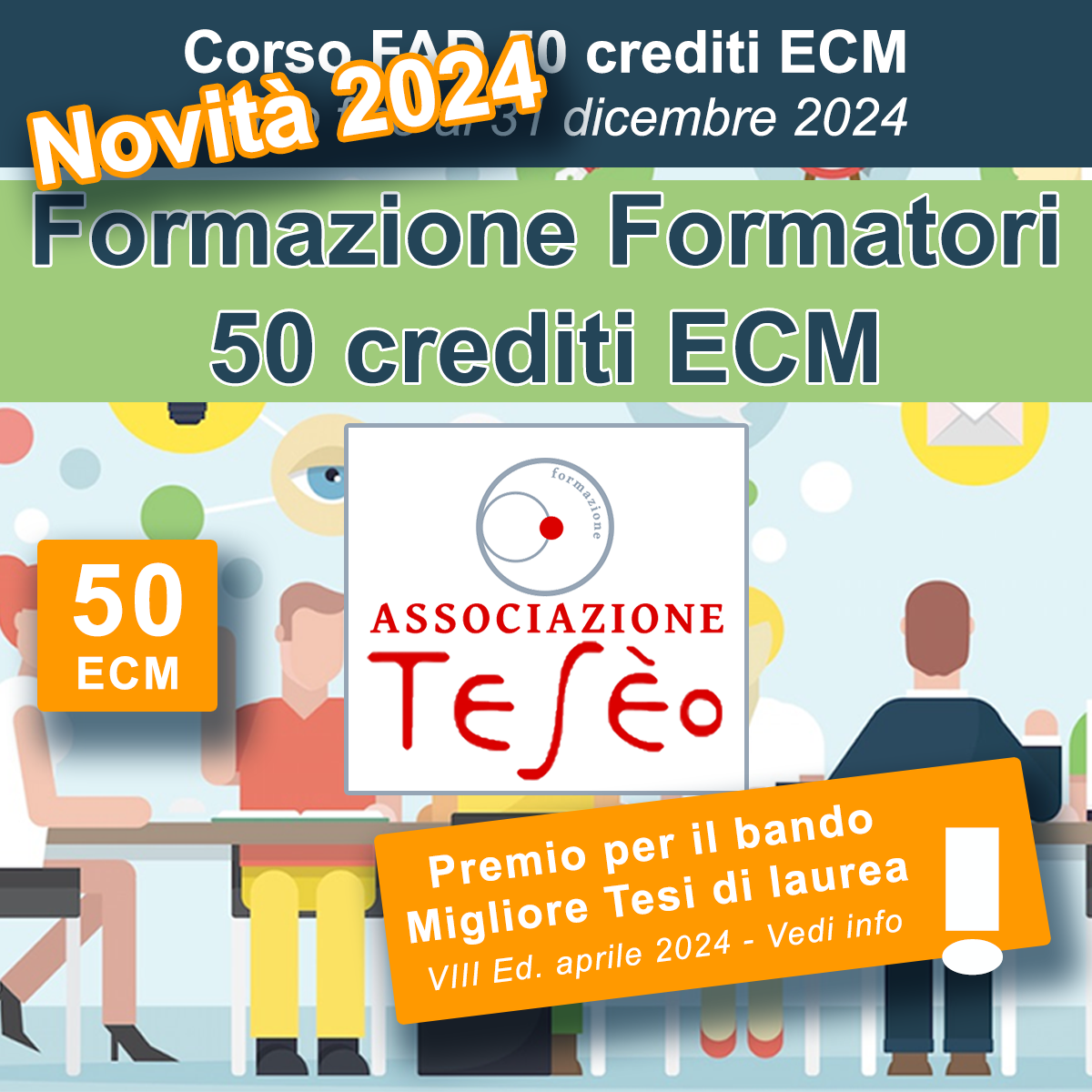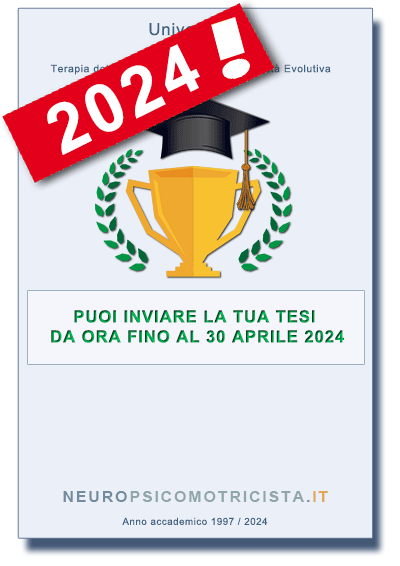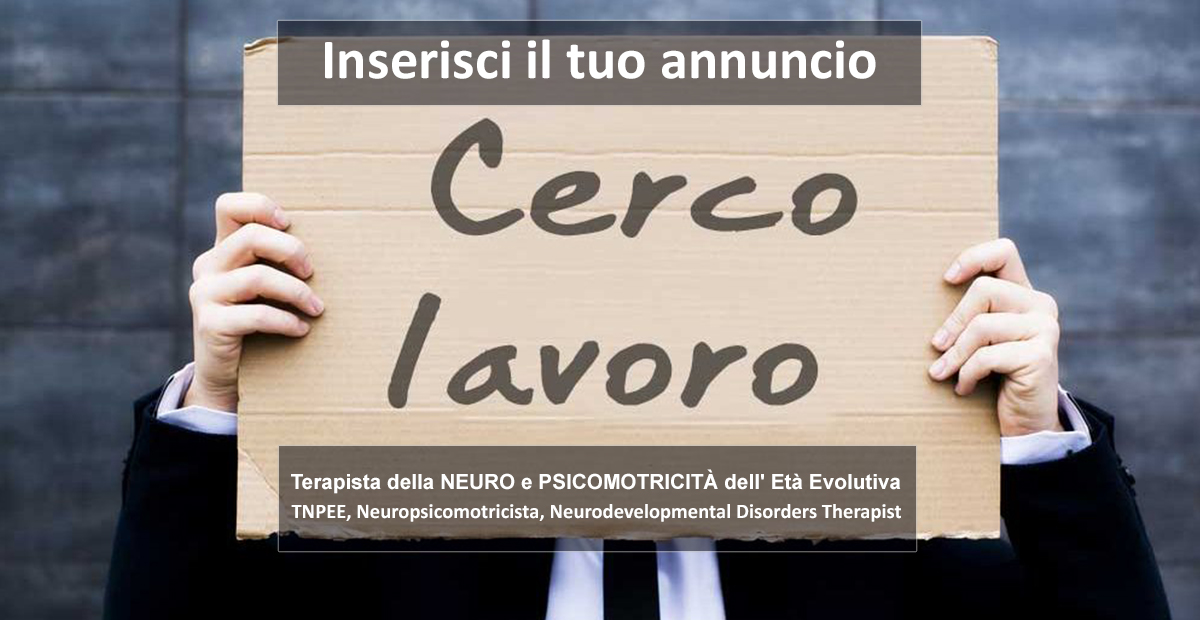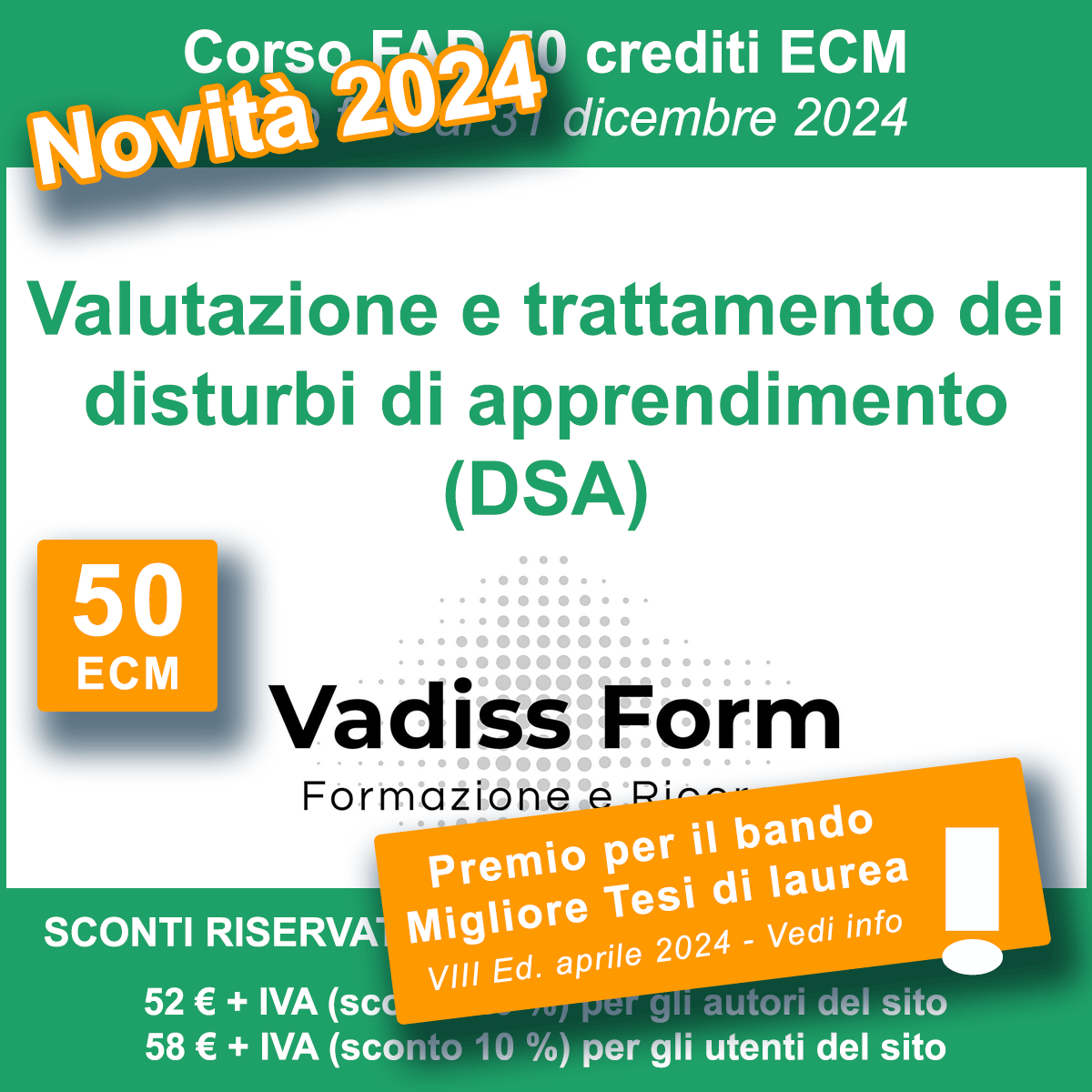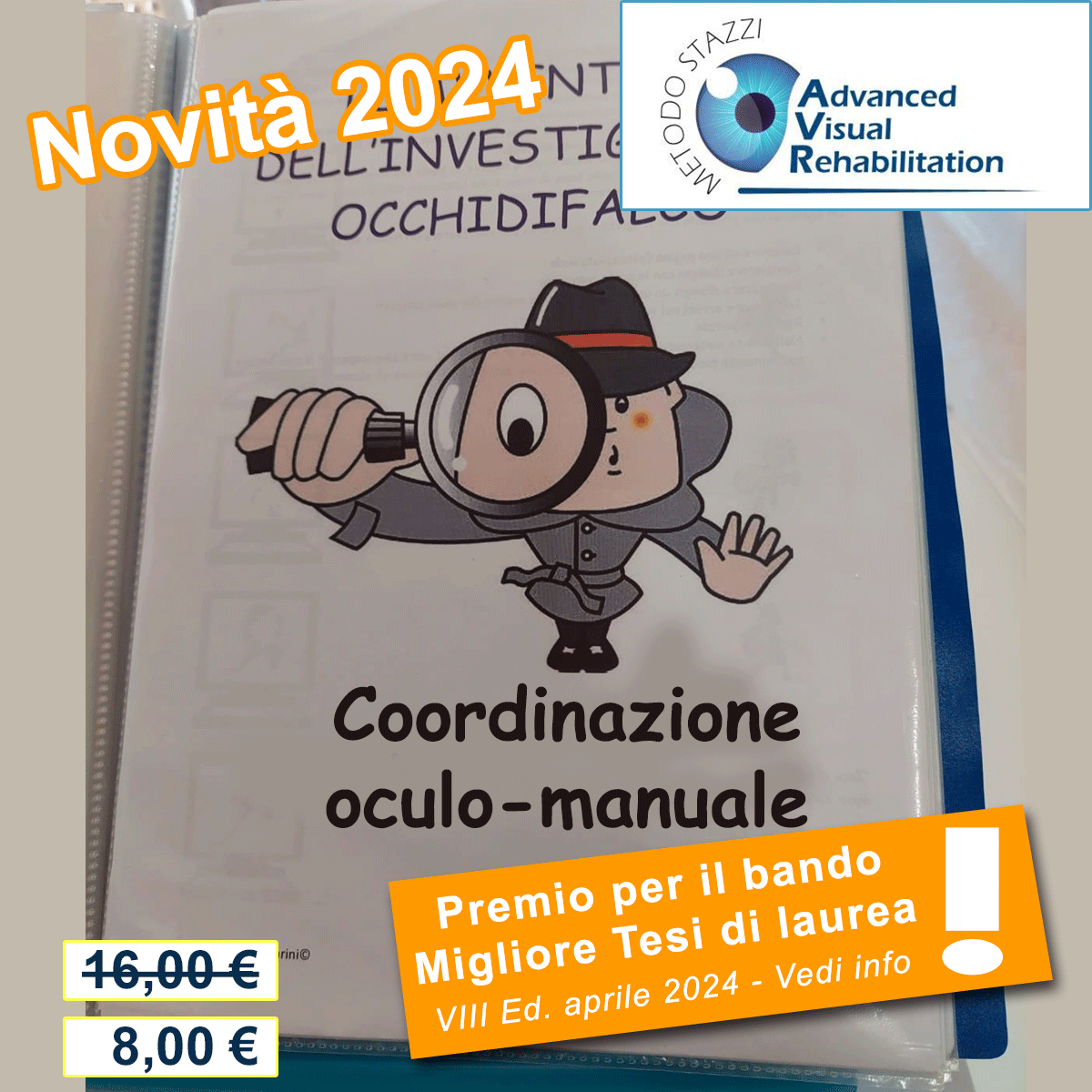BIBLIOGRAFIA - Terapie alternative e complementari nelle Paralisi Cerebrali Infantili
La bibliografia della tesi è riportata sotto ogni paragrafo e capitolo, in modo che sia più facile e immediato il riferimento all'articolo di spunto.
Le fonti degli articoli, degli studi e degli approfondimenti provengono da un archivio dati di riferimento corrispondente alle seguenti pubblicazioni:
- Giornale di Neuropsichiatra Età Evol utiva2011; Vol 31 n.1: “Le terapie alternative e complementari nella ribilitazione delle disabilità dello sviluppo”
- “Complementary and alternative methods in cerebral palsy” W. Looppenheim, Developmental Medicine & Chil neurology 2009, 51
- “Effects of massage on the mechanical behaviour of muscles in adolescents with spastic diplegia: a pilot study” R. Macgregor et al. Developmental Medicine & Chil neurology 2007, 49
- “Controversial treatment of spasticity: exploring alternative therapies for motor function in children with cerebral palsy” J Child Neurol 2003, Rosenbaum P
Questo rappresenta solo la base della letteratura di riferimento, che si è ampliata mano a mano vedendo gli autori rilevanti per l'argomento, controllando i loro lavori nella sezione pubblicazioni dei siti web, e considerando le references legate ed attinenti presenti in bilbiografia.
Ho letto e riportato citazioni di oltre 100 articoli, provenienti o da siti web specifici come:
- www.nccam.nih.gov (National Center for Complementary and Alternative Medicine)
- www.istat.it
- www.TuttoOsteopatia.it
- InternationalSociety for StemCellReasearch. www.isscr.org
- www.stemresearchnews.com
- ClinicalTrials.gov
O da siti ufficialmente riconosciuti, contenenti archivi di letteratura scientifica come:
- www.ncbi.nlm.nih.gov (Pubmed)
- www.isiwebofknowledge.com
- www.cochrane.org
- Entrez Global Query Cross-Database Search System
Bibliografia articoli:
- “Evidence-based Complementary and Alterntive Medicine working group” Wilson K, Mills EJ. J altern complement Med 2002;
- “Validating complementary and alternative medicine and the clash of evidential paradigm”. Evid based Complement Alternat Med 2011
- “Systematic reviews involving complementary and alternative medicine interventions had higher quality of reporting than conventional medicine reviews” J Clin Epidemiol 2005, Lawson ML et al
- 3”Language of publication restrinctions in systematic reviews gave different results depending on wether the intervention was conventional or complementary” L Clin Epidemiol 2005, Pham B et al
- “Developing CAM Research capacity for complementary Medicine. Evid based Complement Altern Med 2006, Lewith G et al
- “Ethics meets complementary and alternative medicine:new light on old principles”Contemporary pediatr 2004,Kemper K etal
- “Controversial treatment of spasticity: exploring alternative therapies for motor function in children with cerebral palsy” J Child Neurol 2003, Rosenbaum P. Conchrane for CAM providers: evidence for action. Alt therap health Med 2003 Manheiner E. ”Evidence based research in complementary and alternative medicine: the process of eidence-based research. Evid Based Complem Altern med 2006, Chiappelli F. Agency for Healthcare Research and Quality. Challenges in systematic reviews of complementary and alternative medice topics. Ann Intern Med 2005, Shekelle Revised standards for reporting interventions in clinical trials of agopunture. Plos Med 2010 Reporting randomized, controlled trials of herbal intervention. Ann Intern Med 2006 ”Complementary and alternative medicine use among adults and children: United States 2007”. Natl Health Stat Report, 2008 ”Complementary and alternative medicine in autism: an evidence- based approach to negotiating safe and efficacious interventions with families”. Neurotherapeutics, 2010 ”Holistic and Integrative Medicine. The use of complementary and alternative medicine in pediatrics” Pediatrics 2008 Istituto Nazionale di Statistica (ISTAT). Le terapie non convenzionali in Italia, anno 2005. “On the influence of abnormal parturitium, difficult labours, premature birth, asphyxia neonatorum on the mental and physical condition of the child, especially in the relation of deformities” W. J. Little, 1862. “ Die infantile cerebrallahmung in Spezialle pathologie und therapie” S.Freud 1897 “Terminology and classification of cerebral palsy” Dev Med Cild Neurol M. Bax 1964 “The changing panorama of cerebal palsy in Sweden” Acta Pediatric Scand. Hagberg, 1975 Ferrari A (2000) I problemi percettivi connessi ai disordini motori della paralisi cerebrale infantile. Giorn ital Med Riab “The efficacy of Adeli suit treatment in children with cerebral palsy” Turner AE. Dev Med Child Neurol 2006 ”Comparison of efficacy of adeli suit and neurodevelopmental treatents in children with cerebral palsy” Barhaim S, Dev Med Chil Neurol 2006 ”Alternative Therapies for children with cerebral palsy” Weisleder P, Clin Pediatr 2010 ”Management of motor problems in cerebral palsy: a critical update for the clinician” Papavasiliou, Eur J Pediatr Neurol 2009 ”The effects of physical therapy on cerebral palsy: a controlled trial in infants with spastic diplegia. Palmer FB, N Eng J Med, 1998. ”Hyperbaric oxygenation for cerebral palsy” Neubauer RA. Lancet 2001 ”Mechanism of hyperbaric oxygen preconditioning in neonatal hypoxia-ischemia” Li Z et al. Brain Res 2008 ”Hyperbaric oxygen and cerebral palsy: no proven benefit and potential harmful” Essex C. Dev Med Child Neur 2003 ”Systematic review of hyperbaric on therapy for CP: the state of the evidence. McDonagh MS,Dev Med Chil Neurol 2007 “Hyperbaric oxygen for children with cerebral palsy: a randomised multicentr trial.” Collet et al, 2001 Gior Neuropsich Età Evol 2011; Vol 31 n. 1 pag. 49 ”Skeletal muscle adaptability:muscle proprieties following chronic electrical stimulation”Lieber RL.DevMedChildNeurol 1986 ”Electrical treatment of spasticity. Reflex tonic activity in hemiplegic patients and selected specific electrostimulation” lfieri V. Rehabil Med 1982 Managing equinus in children with CP:electrical stimulation to strengthen triceps”Cmick J. Dev Med Child Neurol 1995 ”Neuromuscolar electrical stimulation and dynamic bracing as a treatment for upperextremity spsticity in children with CP.” J Hand Surg Br 1999 ”Therapeutic effects of functional eletrical stimulation of the upepr limb of 8 children with CP”. Wright PA,Dev Med Child Neurol 2000 Merzenich 2000 Dev Med Child Neurol, Jenkins 1987 Brain Res, Wang 1995 Nature. ”Electrical Stimulation in Cerebral Palsy: a randomized controlled trial. Kerr C, Dev Med Child Neurol 2006 ”A randomized controlled trial of different intensities of physioterapy in different goal-setting procedures in 44 children with CP” Bower E, Dev Med Child Neurol 1996 “A randomized controlled trial of PT in 56 children with CP followed for 18 months.” Bower E, Dev Med Child Neurol 2001 “The impact of prehension and fine motor development on gross motor activity in children with CP” Hallan PM, UN of Liverpool 1996 “Neurodevelopmental therapy and upper-extremity inhibitive casting for children with CP.” Law M,DevMedChildNeurol 1991 “A comparision of intensive neurodevelopmental therapy plus casting and a regular occupational therapy program for children with CP.” Law M, Dev Med Child Neurol 1997 “Effect of intensive neurodevelopmental treatment in gross motori function of children with CP”. Tsorlakis N,DevMedChild Neurol 2004 “Recovery of muscle strenght following multi-level surgery in diplegic CP” Seniour M, Gait and Posture 2007 “Constraint-Induced movement therapy in the treatment of the upper limb in children with hemiplegic CP” Haare BJ; Cochrane Database Syst Rev 2007 “Effectiveness of osteopathy in the cranial field and myofascial release versus acupunture as complementary treatment for children with CP: a pilot study” Duncan B. et sl, J Am Osteopath Assoc 2008 “Controversial treatment of spasticity: exploring alternative therapies for motor function in children with cerebral palsy. “ Rosenbaum P. J Child Neurol, 2003 “Cranial osteopathy for children with cerebral palsy:a randomised controlled trial” K.Wyatt, V.Edwards, A.Maddick L.Frank, et al. Arch Dis Child, 2011 ”The effects of osteopathic treatment on constipation in children with cerebral palsy: a pilot study.” Tarsuslu T, Bol H et al; J Manipulative Physiol Ther 2009 “Report of interviews with osteopaths from the Osteopathic Centre for Children.” Edwards V, Logan S et al London, 2004 ”Survey of paediatric complementary and alternative medicine use in health and chronic illness.” McCann LJ, Newell SJ.Arch Dis Child, 2006 ” Defecation disorders in the neurologically impaired child” Bi shop PR, Nowi cki MJ. Pediatr Ann 1999 “Gastrointestinal manifestations in children with cerebral palsy.” Guidice ED, Staiano A, et al. Brain Dev1999 ”Effect of an equine-movement therapy program on gait, energy, and motor funtion in children with CP”.DevMed ChildNeurol McGibbon NH et al. 1998 Horseback riding in children with CP: effect on gross motor function” Sterba J, Rogers B. et al.Dev Med Child Neurol 2002 “Therapeutic effects of horseback ridind therapy on grosso motor function in children with CP: a systematic review” Whalen CN, Case-Smith J. Phys Occup Ther Pediatr 2012 ”Alleviating distress during antepartum hospitalization: a randomized controlled trial of music and recreation therapy” Bauer CL, Victorson D et al. J Women Health 2010 ”Functional specialization of music processing in the human born brain” Perani D, Saccuman MC, Proc Nat Acad Scie 2010 ” The phycophysiological effects of music therapy in intensive care units” Austin D, Paediatr Nurs 2010 ” Effect of music by Mozart on energy expenditure in growing preterm intants” Lubetzke R, Mimauni FB et al. Pediatrics 2010 “Il punto sulle staminali” Le Scienze. L. Conti, E. Cattaneo, 2011 “Generation of neurons and astrocytes from isolated cells of the adult mammalian central nervous system". Science. B.Reynolds, S.Weiss, 1992 “ The potential of human cell” Human biotechnology as Social Challenge, Ashgate Publishing, 2007 “ The definition and etymology of the word pluripotency” Journal of Cellular Biotechnology, Byrne, James, 2011. Report: InternationalSociety for StemCellReasearch. Report: National Institues of Health on Dr. Stocum DL, 2001 ”Update on stem cell therapy for cerebral palsy” J.E. Carroll,R.W. Mays, Expert Opin Biol Ther,2012 “A Randomized Study of Autologous Umbilical Cord Blood Reinfusion in Children With Cerebral Palsy” Joanne Kurtzberg, Duke University Medical Center “Safety and Effectiveness of Cord Blood Stem Cell Infusion for the Treatment of Cerebral Palsy in Children” James E. Carroll, Georgia Health Sciences University http://clinicaltrials.gov “Adult stem cell therapy for acute brain injury in children.”Carroll JE, BorlonganC. Neurological Disorders, 2008 “Intravenous infusion of bone marrow mesenchymal stem cells improves brain function after resuscitation from cardiac arrest.” Wang T, Tang W, Sun S, et al. Critical Care Medicine 2008 “Transplantation of placenta-derived mesenchymal stromal cells upon experimental stroke in rats”. Kranz A, Wagner DC, Kamprad M, et al. Brain Research 2010 “Therapeutic benefits of human mesenchymal stem cells derived from bone marrow after global cerebral ischemia.” Zheng W, Honmou O, Miyata K, et al. Brain Research 2010 ”Cerebral transplantation of encapsulated mesenchymal stem cells improves cellular pathology after experimental traumatic brain injury.” Heile AM, Wallrapp C, Klinge PM, et al. Neuroscience Letters 2009 “Human cord blood transplantation in a neonatal rat model of hypoxic-ischemic brain damage: functional outcome related to neuroprotection in the striatum”. Pimental-Coelho PM, Magalhaes ES, Lopes LM, et al. Stem Cells & Development 2010 ”Intravenous administration of human umbilical cord blood reduces neurological deficit in the ratr after traumatic brain injury.” Lu D, Sanberg PR, Mahmood A, et al. Cell Transplantation,2002 “Human umbilical cord blood cell do not improve middle cerebral artery occlusion in rats.”MakinenS et al.BrainResearch20 “Human embryonic stem cell-derived oligodendrocyte progenitor cell transplants remyelinate and restore locomotion after spinal cord injury.” Keirstead HS, Nistor G, Bernal G, et al. J of Neuroscience 2005 ”Transplanted human embryonic neural stem cells survive, migrate, differentiate and increase endogenous nestin expression in adult rat cortical pre-infarction zone.” Zhang P, Li J, Liu Y, et al. Neuropathology 2009 “ Treatment of hypoxic-ischemic encephalopathy in mouse by transplantation of embryonic stem cell derived cells.”Ma J, Wang Y, Yang J, et al. Neurochemistry International 2007 “Anti-inflammatory mechanism of travascular neural stme cell transplantation in haemorrhagic stroke.”Lee ST, Chu K, Jung KH, et al. Brain 2008 neonatal hypoxic-ischemic rats” Yasuhara T, Hara K, Maki M, et al.Journal of Cerebral blood Flow and Metabolism 2008; ”Transplanted neural stem cells survive, differentiate, and improve neurological motor function after experimental traumatic brain injury” Reiss P, Zhang C, Saatman K, et al. Neurosurgery 2002; ”Human bone marrow stem cells exhibit neural phenotypes and ameliorate neurological deficits after grafting into the ischemic brain of rats.” Zhao LR, Duan WM, Reyes M, et al. Exp Neurology 2002; - “Marrow stromal cells migrate throughout forebrain and cerebellum, and they differentiate into astrocytes after injection into neonatal mouse brains”Kopen GC, Prockop DG, Phinney DG. Proc Natl Academy Sci 1999 “Adult bone marrow-derived cells recruited during angiogenesis comprise precursors for periendothelial vascular mural cells.”Rajantie I, Llmonen M, Alminaite A, et al. Blood 2004; “ ntravenous administration of marrow stromal cells (MSCs) increasers the expression of growth factors in rat brain after traumatic brain injury.” Mahmood A, Lu D, Chopp M. J Neurotrauma 2004 “Acute neurological complications after hematopoietic stem cell transplantation in children” Rubin J, Wide K, Rermberger M, et al. Pediatric Transplantation 2005 “Encephalopathy in pediatric patients after allogeneic hematopoietic stem cell transplantation is associated with a poor prognosis.” Woodward P, Helton K, McDaniel H, et al. Bone Marrow Transplantation 2004 Per il questionario ho preso spunto per le TAC in generale dalla letteratura da un proget work intitolato “Medicine Complementari Alternative, tra medicamento e condizionamento .Una cura differente.” Programma “Scienziati in Azienda” - XI Edizione Stresa, 27 Settembre 2010 – 12 Luglio 2011. Tutta la parte specifica riguardante le PCI e la riabilitazione integrativa è stata creata da me
Indice |
| INTRODUZIONE |
|
PARTE TEORICA/DOCUMENTATA Cap 1 - La Medicina Alternativa e Complementare
Cap 2 - Le Paralisi Cerebrali Infantili
PARTE PRATICA DI SONDAGGIO Sondaggio conoscitivo all'interno delle famiglie sulle Terapie Alternative e Complementari
Cap 4 - DATI SUL CAMPO
|
| CONCLUSIONI |
| BIBLIOGRAFIA |
|
Tesi di Laurea di: Ilaria PESAVENTO |


